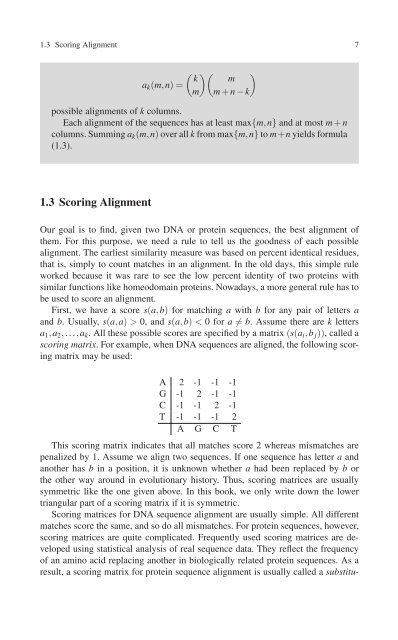You also want an ePaper? Increase the reach of your titles
YUMPU automatically turns print PDFs into web optimized ePapers that Google loves.
1.3 Scoring Alignment 7<br />
( )<br />
k m<br />
a k (m,n)=<br />
m)(<br />
m + n − k<br />
possible alignments of k columns.<br />
Each alignment of the sequences has at least max{m,n} and at most m + n<br />
columns. Summing a k (m,n) over all k from max{m,n} to m+n yields formula<br />
(1.3).<br />
1.3 Scoring Alignment<br />
Our goal is to find, given two DNA or protein sequences, the best alignment of<br />
them. For this purpose, we need a rule to tell us the goodness of each possible<br />
alignment. The earliest similarity measure was based on percent identical residues,<br />
that is, simply to count matches in an alignment. In the old days, this simple rule<br />
worked because it was rare to see the low percent identity of two proteins with<br />
similar functions like homeodomain proteins. Nowadays, a more general rule has to<br />
be used to score an alignment.<br />
First, we have a score s(a,b) for matching a with b foranypairoflettersa<br />
and b. Usually, s(a,a) > 0, and s(a,b) < 0fora ≠ b. Assume there are k letters<br />
a 1 ,a 2 ,...,a k . All these possible scores are specified by a matrix (s(a i ,b j )), called a<br />
scoring matrix. For example, when DNA sequences are aligned, the following scoring<br />
matrix may be used:<br />
A 2 -1 -1 -1<br />
G -1 2 -1 -1<br />
C -1 -1 2 -1<br />
T -1 -1 -1 2<br />
A G C T<br />
This scoring matrix indicates that all matches score 2 whereas mismatches are<br />
penalized by 1. Assume we align two sequences. If one sequence has letter a and<br />
another has b in a position, it is unknown whether a had been replaced by b or<br />
the other way around in evolutionary history. Thus, scoring matrices are usually<br />
symmetric like the one given above. In this book, we only write down the lower<br />
triangular part of a scoring matrix if it is symmetric.<br />
Scoring matrices for DNA sequence alignment are usually simple. All different<br />
matches score the same, and so do all mismatches. For protein sequences, however,<br />
scoring matrices are quite complicated. Frequently used scoring matrices are developed<br />
using statistical analysis of real sequence data. They reflect the frequency<br />
of an amino acid replacing another in biologically related protein sequences. As a<br />
result, a scoring matrix for protein sequence alignment is usually called a substitu-

















